Check The Specs...
NAME: Mike Belan
LOCATION: Oil Springs, Ontario
FARM: Belan Farms
YEARS NO-TILLING: 26
CROPS: Corn, soybeans and winter wheat
High interest rates were the push my dad and uncle needed to make the switch to no-till on our farm. They had long raised wheat, corn and soybeans on our generally flat Brookston clay fields that sit just 30 miles north and south, respectively of Lake Erie and Lake Huron.
It’s not that we were pushed into no-till exactly; it was just a smart financial decision at the time. As interest rates climbed ever higher through the late 1980s, replacing equipment on credit would have meant paying dearly. Instead, my dad, Mike Belan Sr., and uncle, Tony Belan, decided in 1991 to liquidate their plows, cultivators and big tractors. They kept two tractors and used their proceeds to purchase a no-frills 30-foot John Deere 750 no-till drill, which we still own and use to this day.
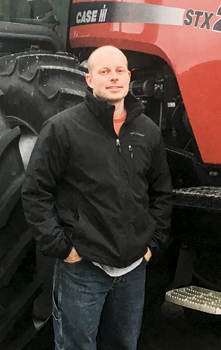
Mike Belan
We quit tillage cold turkey and have been absolutely zero-till since then. It was a money decision at the time, but 25 years later we’re very thankful we stopped tilling our soils and didn’t have the equipment around to till even when it was tempting.
In recent years we’ve learned how soil health relates to growing a good crop. And not just in the good years. Our goal isn’t to grow bumper crops — it’s to grow consistent crops. Having soil that’s alive and working has helped counter some of the variability Mother Nature throws our way and even out production.
Improving soil health is now a serious point of consideration when we’re making production decisions. We don’t want our soil performance to plateau. We want it to continue improving, which is why we’ve started using cover crops on all our acres as the next step beyond no-till.
Double Duty
There’s plenty of time to seed cover crops after wheat, but to get them growing and established before frost on corn acres, we have to get them seeded long before harvest. Our solution is interseeding. There are custom applicators who do cover-crop interseeding in our area, but we grew frustrated when we couldn’t get them in our fields at just the right time. Instead of waiting in line, we built our own applicator.
We purchased a small 3-point hitch mounted row crop cultivator and stripped it down to the toolbar. We fitted it with some old corn planter boxes that we set up to spread annual ryegrass, radish and clover seed. It has 12 rows, each with four discs ganged together and fixed at a very slight 3-4% angle, positioned to run just ahead of where each planter box spreads the cover crop between the corn rows. The discs serve to open a bit of pore space so the cover crop seed can get into the soil for a better chance at germination.
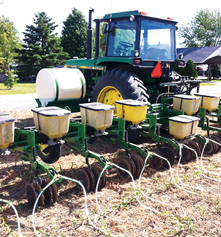
SEED AND FEED. A custom-built rig is used to sidedress nitrogen and interseed cover crops in one pass. Gangs of four discs per row are set to just break the crust of the soil so the seeds broadcasted behind them have a better chance at germination.
The challenge is that working between the corn rows can give weeds an opening, too. We aim to just break the crust to find the happy medium where cover crops benefit but weeds don’t become a problem.
The toolbar is also equipped with a Y-drop system for streaming on liquid 28% nitrogen (N) in the same pass. We sidedress N in a split application during the growing season, once at the 2-leaf stage and again at the 5- to 6-leaf stage. The second application is when we have traditionally seeded the cover crop, but we’re considering trying it on the first pass. With the earlier planting, we’re thinking the cover crop will have more time to germinate and grow a bit before the corn shades out the space between the rows.
So far we’ve had good luck with the later timing. The cover crop comes up and when the corn leaves shade over the row in late July to early August, the cover crop stops growing and sits in a holding pattern while the crop grows. When the corn crop starts to dry down in late September and light starts penetrating the row, the cover crop takes off again.
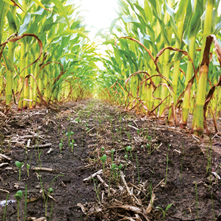
DOUBLING UP. A cover-crop mix of annual ryegrass, clover and radishes sprouts and grows with the corn until the corn leaves shade the row. They’ll stop growing until the corn starts to dry down. Once light penetrates the canopy again, the cover crops will take off and be well established by the time corn is harvested.
Our goal for cover crops in corn is to produce a little N, counteract compaction, and generally build and support soil health. We want something green and growing in the field all year. It’s fun to look down at harvest and see the green coming between the rows.
The cover crop certainly keeps the mud off the tires at harvest, and if you did make any indentation in the field with the harvest equipment, it’s been corrected by January thanks to the roots of the growing plants.
In corn, we seed around 13 pounds of the cover-crop mix per acre. Even though the cover crop is growing at the same time as our crop, we haven’t seen any yield drag from the practice.
After wheat and soybeans we use our drill to seed roughly 15 pounds of a variety of cover-crop mixes. We’ve experimented with 6-, 8- and 12-way blends after wheat that include legumes to produce N for the following corn crop. We’re doing some side-by-side comparisons to see how much N we can produce this way. It hasn’t happened yet, but we can see the writing on the wall that we will eventually be regulated on how much N we can apply. When that day comes, we hope we’re well beyond the initial learning curve so we can continue on without much disruption to our established practices.
Bringing Back Beef
If you go back generations, this area was pastureland, but there hasn’t been any livestock around now for a very long time. The land is simply too valuable as farmland. However, we have seen an opportunity to incorporate cattle into our operation now that we’re using cover crops.
Last year I purchased 500-pound feeder calves and let them graze the corn stubble and the growing cover crop through spring. The calves did great. They didn’t gain like they would in a lot, but they grew and we were able to have them butchered and sell quarters. It was a great way to get a little more mileage out of the cover crops.
Nobody is going to seed back to pastures due to land value here, but cover crops provide an opening. We’re able to get double benefit out of our cover crop investment. It’s not a concrete plan to keep livestock, but we’re definitely exploring the opportunity.
We’re also testing the waters with seeding into green cover crops. As long as the cover crop isn’t too thick we’ve been successful. Typically we spray 1-2 days — at most a week — before planting. We wait as long as possible before doing our burndown to make sure everything is actively growing so we get a thorough kill. We use Roundup Ready soybeans so we can always go in mid-season and clean up anything we didn’t get initially.
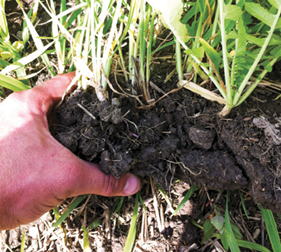
STRONG STRUCTURE. Cover crop roots help carry the weight of harvest, both preventing and reversing compaction. The roots also feed soil organisms, add organic matter and help water infiltration.
Stay Sharp
Dad was the first in the neighborhood to no-till. Since he only bought a no-till drill, he initially had to stick with soybeans and wheat. There was a steep learning curve initially and a yield hit. He was going from heavily working the ground and planting soybeans in 30-inch rows with a planter to no-tilling 7½-inch rows with the drill. He learned in those early years that no-till was about patience.
Patience meant not only were we not the first in the field, but we spent a little more time behind the drill making sure seed was being planted at the right depth, that the trench was being closed, there wasn’t any hairpinning of residue and there was good singulation. That’s a practice we still follow today as we haven’t invested in the technology that can give us that information in the cab.
I’ll get out of the drill or the planter and dig up 10 feet of row to make sure everything is working correctly. If something is off I know to change my speed, adjust down pressure, or just call it a day and try again when conditions are better. This is a process I’ll go through several times in a field.
A lot of observation has led us to make changes to our no-till drill and our planter over the years. About 10 years ago, we started dabbling in no-till corn a bit. After having it custom planted for a few years, we purchased our own basic 12-row John Deere 7000 no-till planter. It has Yetter row cleaners on the front and we’ve made some adjustments to our closing setup.
We’ve opted to use one spiked closing wheel and one half crowfoot Schlagel closing wheel. The Schlagel wheel has tines that are bent to be almost parallel with the soil. When two of the wheels are used together, the tines meet up to make a V pattern in the soil when closing the trench.
With our setup, the spiked closing wheel loosens the soil a bit and then the single Schlagel will run on top of the trench and push the soil down a bit on the seed without causing any sidewall compaction. We’ve tried several closing wheel combinations and found this works best for our conditions.
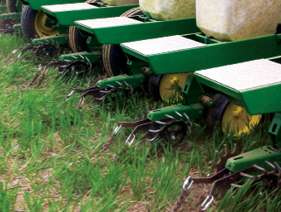
MIX AND MATCH. After experimenting, Mike Belan has found that one spiked closing wheel and one half crowfoot Schlagel closing wheel work best together to close the seed trench without causing sidewall compaction.
One problem we see pop up now and then is hairpinning in the seed trench. That’s one of the things we look for, and if it’s happening we usually fix it by adjusting the row cleaners.
We’ve also had them set too aggressively where they’re working the soil. Ideally, we want them to just clear away anything that’s not rooted into the ground. Anything that’s rooted can stay put because that doesn’t seem to cause any issues.
It’s not always about finding the next best attachment, though. For us, it’s about keeping our current equipment in top form so it can manage seeding through heavy corn residue or cover crop residue. Having less equipment with no-till means we have more time in the winter to take our drill and planter apart and do maintenance.
We replace our opening discs on the drill every 2-3 years. We want the blades nice and sharp, and the boots, gauge wheels, bearings, bushings and any other parts at 100% and ready to go when we hit the field.
Seedboots are also carefully scrutinized. We want to make sure we’re getting seed placed accurately and accuracy decreases significantly as the boot wears. We replace those every 3 years. We also use Keeton seed firmers to help ensure the seed gets exactly where we want.
Like I said, we run a simple system so we’re relying on our equipment, not technology, to ensure we’re planting uniformly. We have to keep our equipment in good shape, monitor it’s performance in the field and make adjustments. We’ve been really working, especially with soybeans, to get better singulation, which sometimes means slowing down, too. We usually aim for about 5 mph for planting.
Our equipment maintenance makes a big difference when cutting through residue. In the past we’ve had issues getting enough down pressure due to having residue on top of the soil. Now, with two-plus decades of building soil structure — along with keeping our equipment in good shape — we have to be careful we’re not applying too much down pressure.
We actually just replaced all the bushings on our no-till drill for the first time since we purchased it. I think that goes to show just how mellow the soil is. The equipment doesn’t wear as hard as it does when you’re dealing with compacted, heavy soils.
Heavy residue is still a concern for us, especially in the case of corn. When we come back and plant soybeans into the corn and cover crop stubble, we find it necessary to up our seeding rate. We’re planting 180,000-190,000 soybean seeds per acre, with the goal of getting a population of 120,000-140,000 plants. We also do our best to avoid the root ball by planting at a bit of an angle to the row. If we go straight down the row and we’re off a little bit, we can end up seeding a whole row of soybeans into that root ball and that can cause problems.
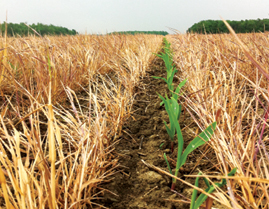
BURNED DOWN. Mike Belan usually aims to burn down his cover crops no more than a week before planting. He wants to make sure the covers, especially annual ryegrass, are actively growing to achieve the best control.
Finding The Middle
My goal for the farm isn’t to hit bumper yields, but to even out production. I want every aspect of the soil working for me every year so I can deal with wet, dry or perfect conditions and still yield. There’s evidence we’re working in the right direction and it all ties back into soil health.
We’re pretty much the only farmers in our area to do 100% no-till. Many no-till wheat and soybeans but then work the ground every third year before corn. When you take a shovelful of our soil you can see the pore space — heck, you can even hear the noise of water sucking in and out of the worm holes if you venture into the field on a wet night (which is kind of creepy). That pore space keeps water moving through the soil profile when it needs to and the organic matter holds onto moisture when it’s dry.
Most of our land is flat. Half is tiled every 30 feet, the other half is tiled every 40-45 feet. I’m always thinking I need to put more tile in the one side, but with cover crops and no-till I notice the water moves away just as fast on both sides of the farm. It makes you question if you really need 20-foot tile spacing if you have root channels and earthworm channels to move the water.
Cover crops are also serving to keep my soil in place. We were doing a field day and the neighbor was working his wheat stubble for the fifth time. It was windy and you couldn’t even see him in the field, there was so much dirt flying around him. In fact, the dirt was moving from his farm to ours.
Getting into the groove of no-till is a slow process but has done wonders for our operation. I’m probably biased because it was established before I started farming so I’ve never plowed, disced or cultivated a field. But I’m grateful that foundation was laid as we continue to move our farm forward.







Post a comment
Report Abusive Comment